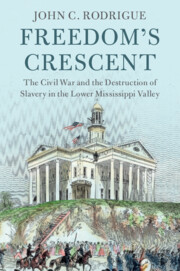Book contents
- Freedom’s Crescent
- Cambridge Studies on the American South
- Freedom’s Crescent
- Copyright page
- Dedication
- Epigraph
- Contents
- Figures
- Acknowledgments
- Abbreviations
- Additional material
- Introduction
- Prologue Life – and Labor – on the Mississippi
- Part I From War for Union to Military Emancipation, 1860–1862
- Part II From Military Emancipation to State Abolition, 1863
- 5 “The Return of the Seceded States to This Union as Slave States”
- 6 “Repugnant to the Spirit of the Age”
- 7 “The Greatest Question Ever Presented to Practical Statesmanship”
- 8 “The Name of ‘Slavery’”
- 9 “Repudiating the Emancipation Proclamation and Reestablishing Slavery”
- Part III Abolition: State and Federal, 1864
- Part IV The Destruction of Slavery, 1865
- Epilogue Memphis and New Orleans: May 1–3 and July 30, 1866
- Bibliography
- Index
8 - “The Name of ‘Slavery’”
from Part II - From Military Emancipation to State Abolition, 1863
Published online by Cambridge University Press: 19 January 2023
- Freedom’s Crescent
- Cambridge Studies on the American South
- Freedom’s Crescent
- Copyright page
- Dedication
- Epigraph
- Contents
- Figures
- Acknowledgments
- Abbreviations
- Additional material
- Introduction
- Prologue Life – and Labor – on the Mississippi
- Part I From War for Union to Military Emancipation, 1860–1862
- Part II From Military Emancipation to State Abolition, 1863
- 5 “The Return of the Seceded States to This Union as Slave States”
- 6 “Repugnant to the Spirit of the Age”
- 7 “The Greatest Question Ever Presented to Practical Statesmanship”
- 8 “The Name of ‘Slavery’”
- 9 “Repudiating the Emancipation Proclamation and Reestablishing Slavery”
- Part III Abolition: State and Federal, 1864
- Part IV The Destruction of Slavery, 1865
- Epilogue Memphis and New Orleans: May 1–3 and July 30, 1866
- Bibliography
- Index
Summary
Evolution of labor and reconstitution of plantation system on sugar and cotton plantations of lower Mississippi valley during 1863. Sugar and cotton reflect different regimens but also share characteristics in common: conflict between former slaveholders and former slaves over new modes of work; Federal officials fear dependency of freed people on government support; plantation-leasing system to northern transplants intended to bring free-labor notions to South. Planters determined to reestablish labor control; freed people determined to achieve meaningful economic independence. Wartime military free labor in sugar and cotton regions encounters many difficulties, and all parties express dissatisfaction with system. By end of year, calls for reformed system for 1864. Military free labor essential step in moving from emancipating slaves to abolishing slavery, but also reveals shortcomings of military emancipation.
- Type
- Chapter
- Information
- Freedom's CrescentThe Civil War and the Destruction of Slavery in the Lower Mississippi Valley, pp. 165 - 184Publisher: Cambridge University PressPrint publication year: 2023

